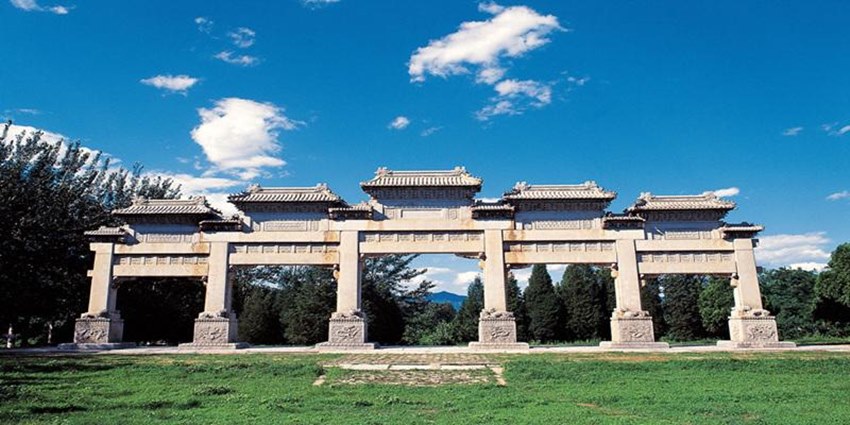Chinese Name: 明十三陵 Pronunciation: Míng Shísān Líng
Building Time: 1409
Recommended Time for Visit: 2 Hours
Address: Ming Shisan Ling Area, Changling Town, Changping District, Beijing.
Best Visiting Season: Spring and Autumn (March to May, September to November)
Building Function: Imperial Mausoleum of Emperors of the Ming Dynasty (1368 - 1644), it was built to bury the Emperors and their families of the Ming Dynasty.
| Tickets |
Peak Season
(April 1st to October 31st)
|
Low Season
(November 1st to March 31st)
|
| Changling | 45 yuan | 30 yuan |
| Dingling | 60 yuan | 40 yuan |
| Zhaoling | 30 yuan | 20 yuan |
| Sacred Way | 30 yuan | 20 yuan |
| The Juyongguan Great Wall | 40 yuan | 35 yuan |
| Joint Ticket (Dingling+Changling+Sacred Way) |
110 yuan | |
| Ticket Office Opening Hours | 8:00-14:30 | |
| Note: Free for Child (Under 6 years old or under 1.3m in height) and Senior (Over 60 years old) Please get the ticket at the corresponding ticket counter with an ID card or passport. |
||
|
Attractions
|
Peak Season (May 1st to October 31st)
|
Low Season (November 1st to April 30th)
|
| Changling | 08:30 - 16:30 | |
| Dingling | ||
| Zhaoling | ||
| Sacred Way | ||
| The Juyongguan Great Wall | ||
| Tips: The opening hours may change after the epidemic situation | ||
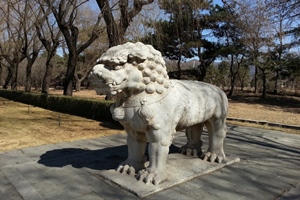
Located in Changping District, 50 kilometers (31 miles) north from the downtown area of Beijing, the Ming Tombs is at the foot of Tianshou Mountain, covering a total area of over 120 square kilometers (46.3 square miles). It is the imperial cemetery of the 13 emperors of the Ming Dynasty (1368-1644). The site was carefully selected according to the Chinese Feng-Shui (geomantic omen) tradition, and the Ming Tombs are surrounded by mountains on three sides and a river flows near them.
The Ming Tombs has been listed by UNESCO as World Cultural Heritage, it is world-famous because the 13 emperors of the Ming Dynasty were buried with lots of unique relics. There are 13 imperial tombs, 7 concubines tombs and a eunuch’s tomb are scattered in the valley. The layout of the scenic area of all the mausoleums is similar, but their size and complexity of structure are various. Each mausoleum has its independent unit with a certain distance between them.
There is a main road - the Sacred Way, and it directs visitors to different imperial mausoleums. The Ming Tombs is preserved very well and has a complete system. At present, Changling Tomb, Dingling Tomb, Zhaoling Tomb and the Sacred Way are available for the people to visit. All these are the outstanding historical site and demonstrate exquisite ancient Chinese architecture and traditional culture.
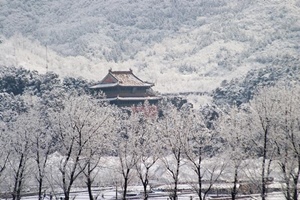
The Ming Tombs has a long history, and it boasts high historic and cultural values due to it took more than 200 years during the Ming Dynasty. The construction of Ming tombs started in 1409 and ended in 1644.
In 1409, Zhu Di, the first emperor of the Ming Dynasty, built his Changling Tomb, then the successive 12 emperors had their mausoleums built around Changling during the next 230 years. All these mausoleums are well preserved and called the Ming Tombs.
Since 1949, the Ming Tombs is restored and maintained after the founding of the People’s Republic of China. The government took great effort and provided financial support to conserve cultural heritage every year.
In 1957, the Ming Tombs was promulgated by Beijing Municipal Government as one of the first batches of key ancient architecture and cultural heritage conservation sites. Then, it was listed as the national priority cultural relic protection sites in 1961.
In 1982, the Ming Tombs area was announced as a national key scenic spot by State Council. It was regarded as one of the best 40 scenic spots in China by the National Tourism Administration in 1991.
In 1992, the Ming Tombs was evaluated as the most preserved imperial cemetery with the most emperors buried in the world by the selection and evaluation committee of the World Top of Beijing Tourism.
In 2003, the Ming Tombs was inscribed into the World Heritage List by UNESCO.
In 2007, the Ming Tombs was officially approved as a national 5A tourist attraction by the National Tourism Administration. Millions of tourists come to the site to appreciate its long history and palatial architecture every year.
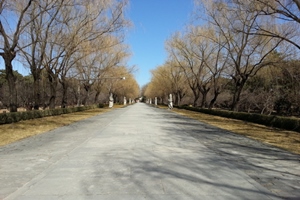
Sacred Way was originally built as the front part of imperial mausoleums and finished in 1540. The total length of Sacred Way is 7.3 kilometers. It is regarded as the main road of Ming Tombs as well as the way to Changling. Along the way from south to north, people can see the relics of the Ming Dynasty. There are Stone Memorial Arch, Great Red Gate(with Dismounting Steles at both sides), Stele Pavilion of Divine Merits and Sacred Virtues, Stone Statues and Animals, Dragon and Phoenix Gate, Five-Arch Bridge and Seven-Arch Bridge line.
The Sacred Way is decorated with exquisite stone statues by two sides. There are usually 12 human figures and 24 animals which are important to the mausoleum. It is the art of ancient stone status.
Stone Memorial Arch
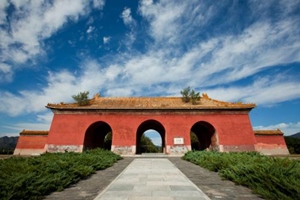
Built-in 1540, the Stone Memorial Arch is the first architecture in Sacred Way, and it is also the earliest and highest level of stone memorial arch existing in China.
Great Red Gate
The Great Red Gate(Dagongmen) is the general gate of imperial mausoleums which is also called the Great Palace Gate, the main entrance to the cemetery with three passageways. The wall of the gate is red and the structure is extraordinary.
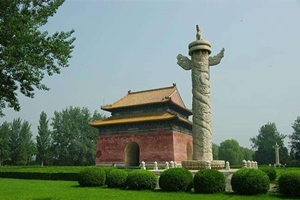
The next building of the Great Red Gate is Stele Pavilion specially built for housing a 6-meter-high stone stele. The tablet inscription has almost 4000 Chinese characters which were written in the first year of Ming Hongxi (1425). Also, there is an article which was written by Emperor Qianlong of the Qing Dynasty to be preserved. It is the situation of the Ming Tombs in details, cost record of repairing and Emperor Jiaqing(1796-1820)’s analysis of the reasons why the Ming Empire fell. At the four corners of Stele Pavilion, there erect two pairs of Huabiao (a kind of Chinese ornamental columns in front of palaces, tombs, etc.).
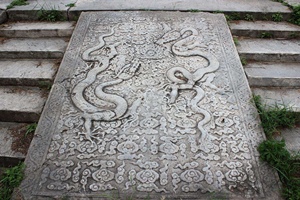
Behind the Stele Pavilion are two lines of vivid stone sculptures of 12 pairs of stone animals and 6 pairs of stone men statues on two sides of the Sacred Way. These sculptures are standing or kneeling there. The beasts can be classified to be six with different implied meaning: lions (brave and good at fighting), haechi (the legendary beast, good at distinguishing the good and the evil), kylins (another legendary beast, the symbol of auspiciousness), horses (a rider, good at running), camels and elephants (loyal and virtuous).
Lions, camels, elephants and horses are four kinds of animals existing in our daily life. Haetaes and kylins are animals in the legend of China.
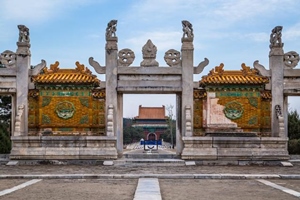
The Dragon and Phoenix (Lingxing Gate) are at the end of the stone sculptures and the last gate on the Sacred Way. It was constituted of carved stone pillars, which forming three passageways. There are three flame balls carved of stone on the upper part of the gate, which gives the gate another name - Flame Archway.
Located at the foot of the main peak of Tianshou Mountain, Changling Tomb is the joint mausoleum of Emperor Yongle and his Empress Xu. It is the earliest and the largest one with a history of about 600 years. It was also the best-preserved imperial tomb among the 13 Ming Mausoleums.
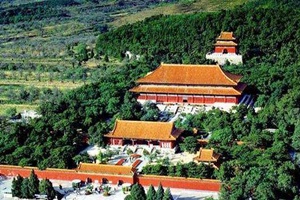
Changling Tomb is at the end of Sacred Way and one of the most important attractions, and it has three courtyards in the front part and a Treasure City in the rear. Passing through the first courtyard, the magnificent Blessing Palace (Ling'en Palace) in the second courtyard is highly recommended which is the most attractive area of the tomb, worthy of careful appreciation.
There are huge pillars and wooden components made of Jinsi Nanmu ( a kind of rare and hardwood), which makes the Ling’en Hall unique. It is also a precious relic of the wooden architecture of ancient China. The ceiling is colorfully painted. The bronze statue of Emperor Yongle is extremely lifelike in the Hall.
Many objects and photos are exhibited in the palace, such as the portrait of Emperor Zhu Di and Empress Xu and the Yongle Encyclopedia, etc. They show the great achievements of Emperor Zhu Di.
In the third courtyard stands a few antique buildings including the Lingxing Gate. The rear part of Changling Tomb is Treasure City which looks like a closed circular castle. The so-called Treasure City is 7 meters(23 feet) in height where Emperor Zhu Di and his Empress Xu were buried.
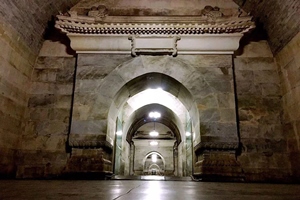
Dingling Tomb is located at the eastern foot of Dayu Mountain, and it is the joint tomb of the thirteenth Ming Emperor Zhu Yijun (1563-1620) and his two Empresses Xiaoduan and Xiaojing. It took 6 years to build the Dingling Tomb and its construction started in 1584 when the Emperor was 28 years old and finished in 1590. The tomb is one of the largest mausoleums which covers an area of 180,000 square meters (44 acres). This imperial mausoleum is the only one that was approved to start excavation by State Council.
The title of the reign of Emperor Zhu Yijun was Wanli and the posthumous name was Shenzong. He ascended the throne when he was 10 years old. After 48 years’ ruling, he died at the age of 58.
The front part Dingling Tomb is square and the rear part is circular. Its layout symbolizing the ancient Chinese philosophical saying "heaven is round and the earth is square". The whole Dingling Tomb is composed of Overground Palace and Underground Palace.
There is a courtyard which has three parts in the Overground Palace. Entering the first part courtyard, there is a single-edged mountain-top mausoleum gate in front of it, named Wailuo Gate, which is the second gate of the mausoleum, also called the Double Gate. There is a door along the wall on each side. There are no building facilities in the courtyard. In front of the courtyard (within the Wailuo Gate), there are three divine kitchens on the left and three divine libraries on the right.
The Ling’en Gate is in the second entrance of the courtyard. And the Blessing and Grace Palace (Ling’en Palace) is in the third part of this courtyard. It is the place for making a sacrifice to Emperor Zhu Yijun and his two empresses.
The circular yard has Treasure City, where the emperor and his empresses were buried. It is covered with earth and the middle part stands out, looking like a castle.
The Underground Palace is composed of five chambers which are the front room, middle room, left side hall, right side hall and rear room respectively. A lot of precious relics were unearthed from Dingling and was displayed to the public in 1959. There are some precious items, such as jades, vases, red lacquer boxes, golden crowns, silver, silk, etc. It is worthy of careful visiting.
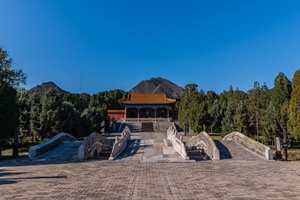
Zhaoling Tomb is located at the eastern foot of Dayu Mountain, which is the joint tomb of Zhu Zaihou, the twelfth emperor and his three empresses of the Ming Dynasty (1368 - 1644). It has been restored times and relatively smaller than other mausoleums, but the structure is similar in terms of architecture and layout. It is a middle size imperial mausoleum, covering an area of about 35 square kilometers(13.5 square miles).
There are Blessing Palace (Ling'en Palace) and other side halls (on the left and the right side), three-room Ling’en Gate, while the Tablet Pavilion, the animal-slaughtering House and the Divine Kitchen are built in front of the tomb palace.
Passing through the Gate of Blessing and Grace of Zhaoling Tomb, people can see a blank stele on a stone turtle standing under a pavilion on the left side of the first yard.
The magnificent Blessing and Grace Palace (Ling’en Palace) is in the center part of the mausoleum which is the main building. Visitors can learn the culture of the Ming Dynasty here. The side halls of Ling’en Palace, in which historical materials about Zhu Zaihou and his empresses as well as other materials of the tombs’ history are displayed for tourists.
The circular yard next to the Ling’en Palace is the final part of the Zhaoling Tomb, where the emperor and his empresses are buried. It included a “dumb yard”, and the legend says the final part of the building was finished by mute workers for keeping secret of the tomb.
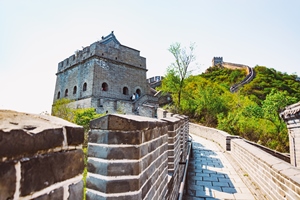
Situated in the west boundary line of the Jundu Mountains, the Juyongguan Pass is the final section of the Taihang Mountains. It had always been the strategic pass of the Great Wall and kept as a guarded passage in ancient China. The walls of the pass are more than 4,000 meters long.
Juyongguan Great Wall is extremely beautiful, the landscape around the pass is very attractive. It was ranked top of the eight most beautiful scenic spots in Yanjing(Beijing) of the Jin Dynasty (1190-1195) and the Emerald Ripples of Juyong was famous for the next 700 years. The ancient buildings around it are still a window for visitors to learn the military affairs and history as well as culture in ancient China.
The Ming Tombs Special Administration of Changping County launched an overhaul of buildings. In 1982, the Juyong Pass was listed as an important part of the Badaling-Ming Tombs Protection Zone of Scenic Spots and Sites of Historic Interest. It has great value both in culture and natural landscape.
Emperor Renzong-Zhu Gaochi’s(1378-1425) burial place is in Xianling mausoleum after his death. There is a small mountain ridge in the middle of the mausoleum, which separates Ling’en Hall(Ling’en means getting the emperor’s blessing) from Baocheng(wall built for protecting the tomb palace) and Minglou(high building before the tomb palace) in the courtyard. The front area is Ling’en Hall with one entrance behind it. Baocheng and Minglou in the back area with a yard in the front. This hill happens to block the Minglou and Baocheng of the cemetery from the front. People name it Zhexiu Hill(Zhexiu means covering some ashamed things). As the legend says, Emperor Renzong, the tomb owner, mistakenly entered his father and concubine’s bedroom when he was still alive. Renzong swore to the sky and denied it to keep the dignity of the Emperor. He asked the dragon to eat himself if there was such a thing. Unfortunately for him, a dragon flying down from the Hall of Golden Chimes, swallowing Renzong in one bite. The ministers hurried to rescue him but only grabbed one of his boots. The successive Emperor Xuanzong had to bury his father’s boot in the mausoleum. He deliberately arranged the mausoleum behind this hill to cover up this matter. The fact is that this hill’s real name in the cemetery is “Yu’an Mountain” which has nothing to do with shame. The real reason for choosing the small hill layout in the middle is because of the Feng Shui(Fengshui claims to use energy forces to harmonize individuals with their surrounding environment) of the cemetery.
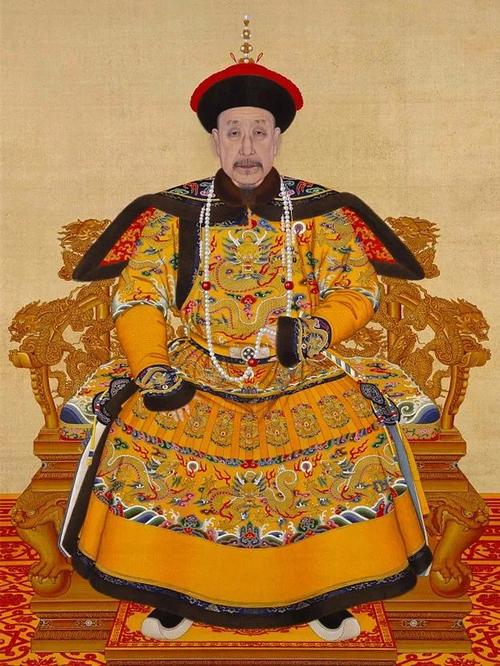
After the Qing Dynasty(1636-1912) became the ruler of the Central Plains, they planed a series of protective measures for the Ming Tombs. A large-scale repair of the Ming Tombs was carried out to avoid ethnic contradictions and the Qing Dynasty hoped the landlord class’s intellectuals of Han Chinese would serve the Qing Dynasty. The tomb repairing lasted from the fiftieth(1785) to fifty-second year(1787) of the reign of Qing Emperor Qianlong. However, they did not complete the renovation projects and did not respect the original building pattern. Some buildings were demolished or rebuilt incompletely. Some people believed that the Qing had changed the large Ming Tombs into one small one. Also, there is a legend of “Qianlong Stealing Wood”, which is widespread. According to the legend, Emperor Qianlong had another purpose to repair the Ming Tombs. He liked the timber nanmu(a precious wood that is unique to China and South Asia) pillars of the Ling’en Hall of Changling and wanted to get it for such excellent wood that people could hardly find at any other place during the Qing Dynasty. He ordered to repair the tomb and attempted to demolish the Changling Hall to get the wood. Due to the Han ministers’ dissuasion from Liu Yong, Ji Xiaolan, and others, Emperor Qianlong reluctantly agreed not to demolish the Changling. However, he ordered people to dismantle the Yongling Hall. He then used the timber nanmu of the temple for the construction of the Old Summer Palace. Of course, this story is just the folklore rather than an official history. However, we can know the Qing government once reduced the construction scales and rebuilt the Six Tombs in the Ming Tombs as judging from the renovation of the cemetery at that time.
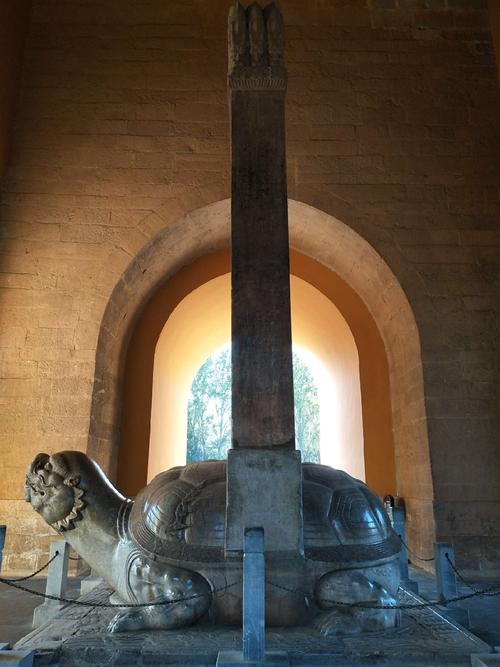
There is a tortoise stele in front of each tomb except Siling mausoleum in the Ming Tombs. It is the monument of virtues. We can see the tortoise under the stele as the stele’s base, and legend goes that the tortoise is the ninth son of dragon in mythology. The dragon gave birth to nine sons and one of them is a heavy-bearing son--tortoise. Tortoise is known for a long life and has been highly valued by people since ancient times. As early as in the slave society, slave owners believed that tortoises have a long life and naturally know more things. Therefore, our ancestors often used tortoise shells for divination. People always used it to predict good or evil according to the shell’s shape after burning them. Then the content of the prophecy was carved on it and preserved.
There is also a reason why the Emperor used tortoise as the stele. The Emperor also is the ‘son’ of dragon in ancient China and the tortoise is the son of the dragon as well as can burden weight. Isn’t it natural to make it to carry his father’s monument? Till now, people still confused that what methods people used to successfully put the monument on the tortoise back at that time. The specific process is not seen in the book record yet, but there is a legend that the tortoise should not see the monument. One ancient Japanese book Wenhaipisha(name in Chinese) recorded such a story “When Ming Chengzu(1360-1424) built a stele for his father Zhu Yuanzhang(1328-1398), the people in charge of the project were anxious that the tortoise was too high and the stele could not stand up on its back. One day, he dreamed that a man of God said to him, “If you want to build this monument, the monument and the tortoise cannot see each other.” After waking up, he thought about it and understood. As he arrived at the construction site, he asked the workmen to transport soil onto the tortoise’s back, bury it, and then pull the monument up along the soil’s slope. And then removed the soil after erecting the stele. Although this historical story is superstitious and the argument that the tortoise does not see the stele is reasonable. This method is the crystallization of the wisdom of the ancient working class.
There was a large scale project starting in the twelfth year(1584) of Wanli reign in the Ming Dynasty. Some officials were general managers of the projects, such as Dingguo Gong(an essential official of ancient China), Xu Wenbi, and assistant minister Shen Shixing. He Qiming, the assistant minister of the Ministry of Industry, supervised the work on site. The workers and soldiers used on site for this project are of a large quantity. According to the legend, when Emperor Shenzong--Zhu Yijun(1563-1620) came to inspect the progress of the project, he was agitated as he saw the craftsmen lazily grinding the bricks. When he checked the project the next year, he saw the craftsmen still grinding the bricks. “You are too slow” he growled, “When will you complete the mausoleum?” One wise craftsman said, “We don't want to build it soon.” Shenzong replied, “How dare you say like that? You delayed my mausoleum project!” He was about to ask the general to kill the craftsman, at the same time, the craftsman said calmly, “Don’t be angry please”. If we complete the mausoleum early, doesn’t it mean you will die soon? We slowly grind it because we don’t want you to die.” The stupid Zhu Yijun was suddenly glad after hearing this.
There is a tortoise stele in front of each mausoleum except Siling. It is the stele of virtues. A white circular trace is on the upper right corner of the Dingling stele’s back, which is still visible today. The magical legend of “Dingling Moon Stele” was widespread among the local people.
Shenzong was notorious for being a ridiculous and self-indulgent emperor in the Ming Dynasty. He became Emperor at the age of ten and started to build a mausoleum for himself at twenty-one. He did not go to court after the completion of his mausoleum. He stayed in the palace drinking and pleasure-seeking for twenty-five years. One day, Shenzong was sleeping and suddenly dreamed that a man walked toward him. The man’s face, hair, and dress were all red. Shenzong was surprised, and hurriedly asked, “Who are you?” The man replied, “To be honest. I am God Fire. I knew you a long time ago that you are a muddleheaded and ferocious emperor. Now, I am following the order to punish you. I am going to burn your Dingling Mausoleum into ashes because you are wasting workforce and money to build it!” Shenzong was furious after hearing this. He shouted that “I am the Emperor and our family will rule the world for thousands of years. I am not afraid of you. All the Gods will protect the Emperor’s mausoleum, so how dare you do that, furthermore you don’t have such ability!” The God Fire asked, “How about we making a bet?” Shenzong answered, “It's up to you.” The God Fire said, “What if the fire burns your mausoleum?” Shenzong replied, “One of my eyes will go blind now if Dingling gets burned in the future.” As soon as his voice faded away, the God Fire went away with laughing and was gone very quickly. Shenzong was taken aback and woke up from his dream. He was about to open his eyes and look around, but his left eye suddenly is blurred. His left eye was blind. Shenzong recalled the scene in his dream and was confused. From then on, he got sick and died within a few days.
Emporer Shenzong died, and his burial place was in Dingling mausoleum. But it was strange that Shenzong opened the right eye all the time, and he couldn’t close it no matter how others try to do. After completing the burial of Shenzong’s body, someone discovered that a white round object immediately appeared in the upper right corner at the Dingling Stele’s back. People were amazed. What is more strange is that this white round thing will shine at the end and the beginning of each lunar month according to local people’s talking. This story is the name origin of the “Dingling Moon Stele”. People said that this white round object was from Shenzong's right eye because he was afraid that the God Fire would come to burn his mausoleum. Nevertheless, Dingling was in the disaster of fire finally and that moon no longer shines anymore.
Take bus 872, 878, 879 and get off at Changping Wangzhuang Station, then walk 400m to Sacred Way;
Take bus 314, 872, 925 and get off at Changling Station directly;
Take bus 314, 872, 878, 879 and get off at Changling Station directly;
By Taxi
Chinese: 请送我去明十三陵。English: Please take me to the Ming Tombs.
Chinese: 请送我去神路。English: Please take me to the Sacred Way.
Chinese: 请送我去长陵。English: Please take me to Changling Tomb.
Chinese: 请送我去定陵。English: Please take me to Dingling Tombs.
If you go to the Ming Tombs from Beijing Capital International Airport, it will take about 70 minutes, 200 yuan.
If you go to the Ming Tombs from Beijing Daxing International Airport, it will take about 100 minutes,380 yuan.
If you go to the Ming Tombs from Beijing West Railway Station, it will take about 70 minutes, 220 yuan.
If you go to the Ming Tombs from Beijing South Railway Station, it will take about 90 minutes, 200 yuan.
